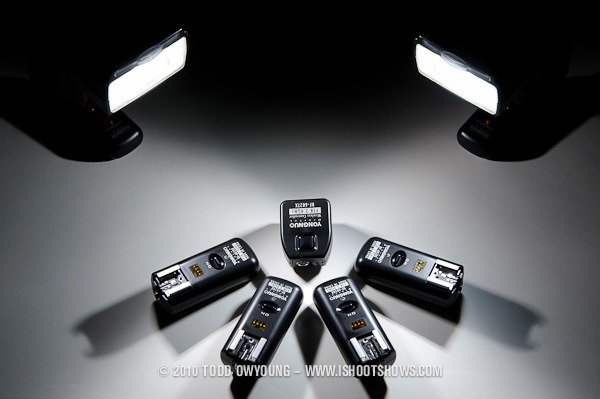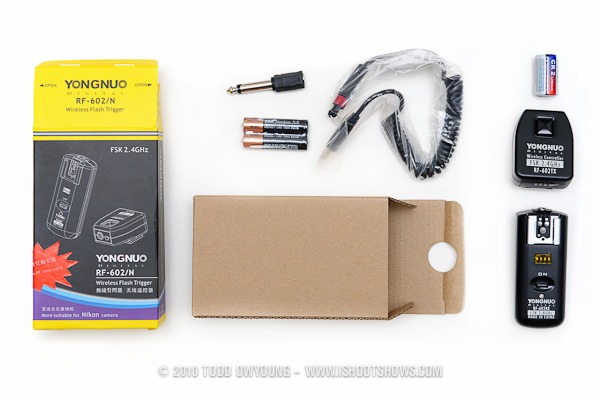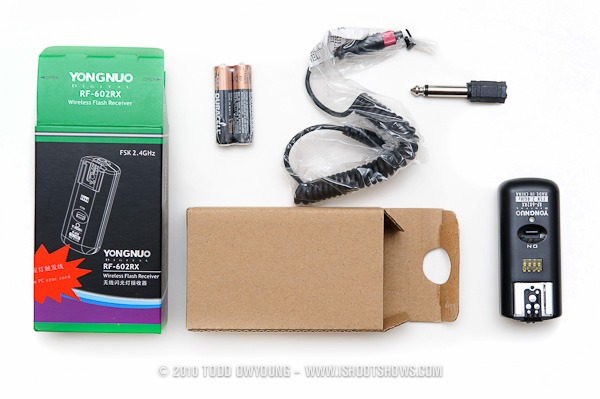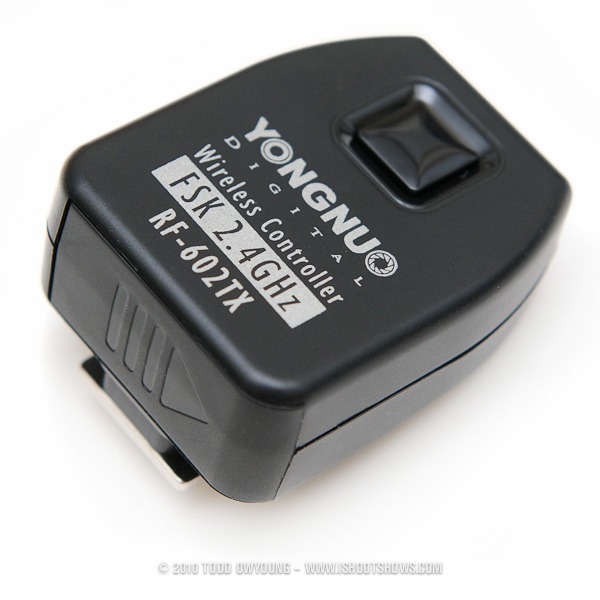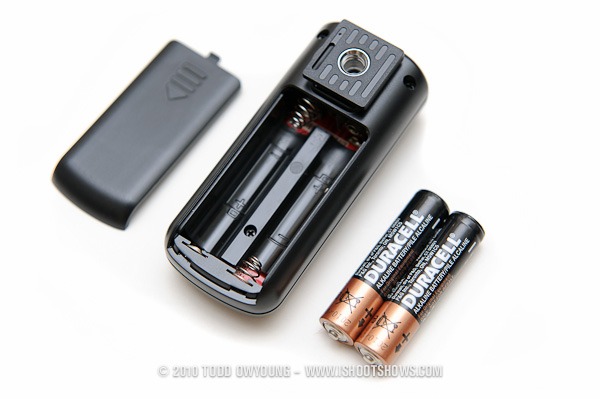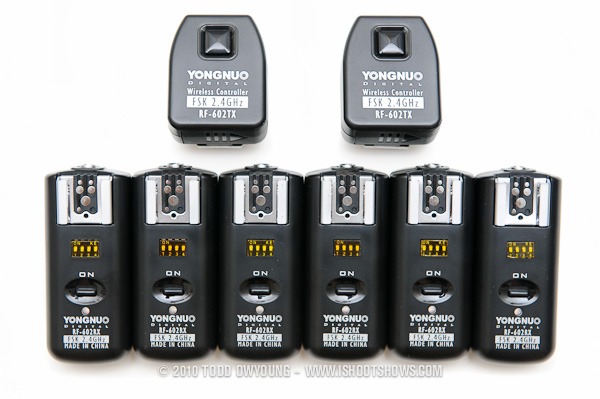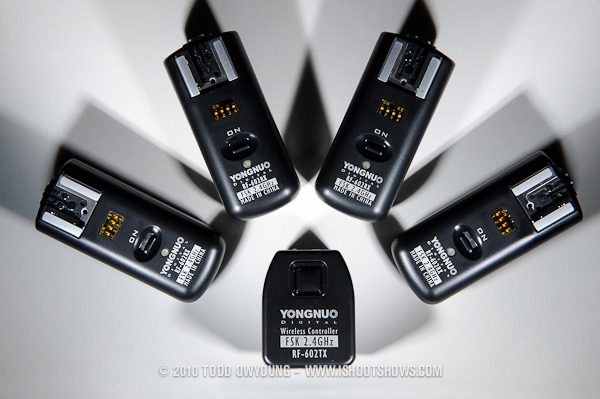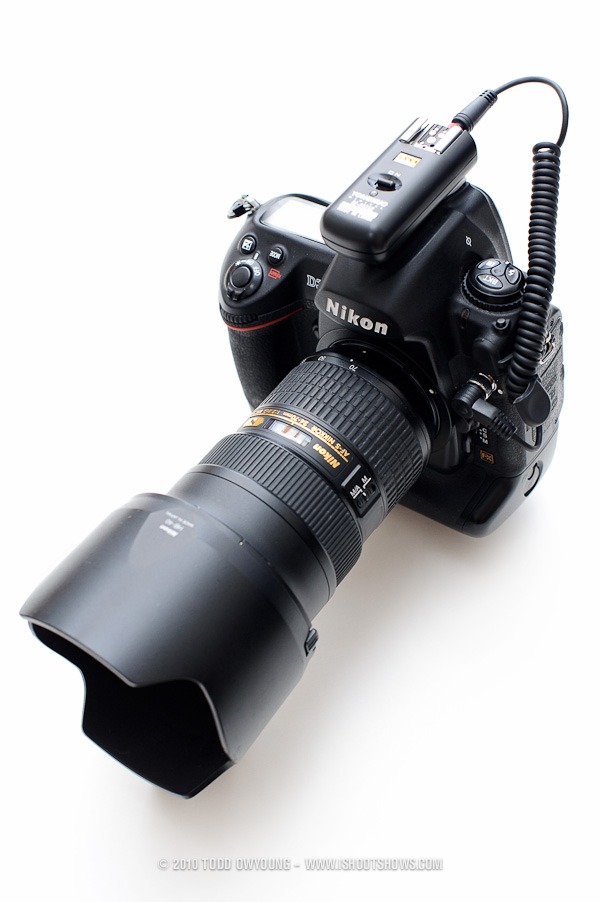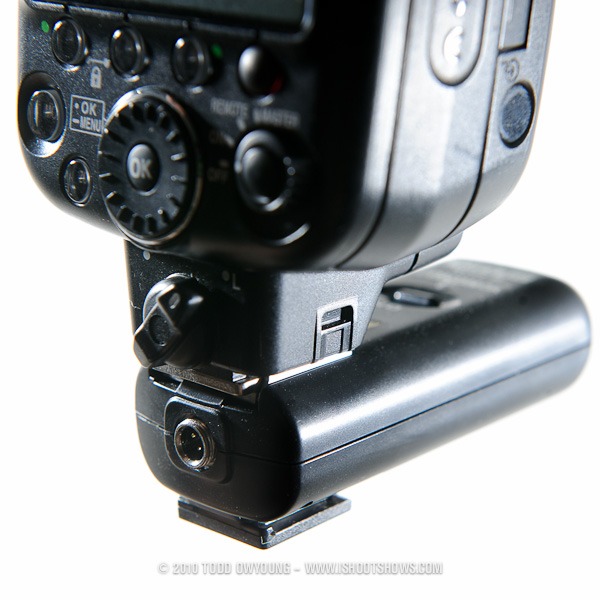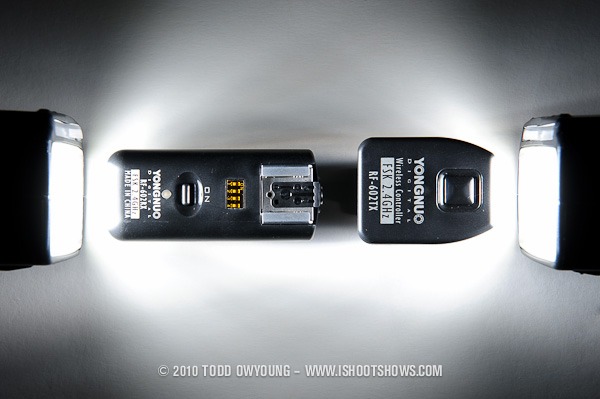
As you may know, I'm a big fan of Nikon's “Creative Lighting System” of wireless flash (CLS) for my portrait work. And with wireless TTL control of up to three remote flash groups without any additional hardware beyond your Nikon speedlights, there's a lot to love.
However, there are lighting situations and setups where IR triggering just isn't enough. Enter the Yongnuo RF-602 Wireless Flash Triggers.
For those shoots where line-of-sight and bounced transmission isn't adequate, and where the speed of adjustments via CLS aren't critical, wireless flash triggers are an inevitable conclusion.
Research – Building An Economical Trigger Kit
In my speedlight kit, I have five speedlights, so for me, a prime concern for a triggering system was cost. Looking at the options for the sort of flash triggering kit I wanted to put together, purchasing a kit of Pocketwizards would have run nearly a cool $1,000 with the tried and true Pocketwizard Plus II models.
Since speedlights are not my end-goal for lighting, buying into half a dozen Pocketwizard units doesn't really add up. My needs were simple: I just need reliable, fool-proof triggering of remote speedlights.
While there are a host of eBay flash triggers flooding the market these days, from my research, the best fit for my needs seemed to be the Yongnuo RF-602. There were triggers with more features, or cheaper triggers like the CowboyStudio NPT-04, but none that seemed to match the reliability, price, and general seal of approval that the Yongnuo RF-602
garnered.
Yongnuo RF-602 Specifications
At their core, the RF-602 are a 2.4GHz wireless flash system with a lot to like.
| Type | 2.4GHz wireless remote sustem |
| Transmitter Range | 100 meters |
| Channels | 15-channels, plus an “all channels” mode |
| Transmitter Terminal | PC 3-Pin input terminal |
| Receiver Terminal | Yongnuo 3-pin output terminal |
| Time of shooting | Up to 20,000 times (Using CR2 Lithium battery) |
| Receiver Stand-by time | Up to 45 hours (Using AAA battery) |
| Dimensions (Receiver) | Receiver : 33 x 78 x 26mm (W x H x D) |
| Dimensions (Transmitter) | Transmitter : 38.4 x 48 x 27mm (W x H x D) |
Ordering:
I went with purchasing from directly from Yongnuo's eBay store, as they seemed the most universally recommended source on the Flickr Strobist Group. Group members noted that they'd had good customer service from Yongnuo through their eBay store, they seemed like a better bet than other retailers. Might as well go straight to the source, right?
Shipping:
I ordered two sets of 3x receivers and 1x transmitters, for a total of 6x receivers and 2x transmitters. Buying two sets turned out to be the most economical combination at a total of $143.98 shipped. Again, less than the price of one Pocketwizard Plus II.
I ordered from Yongnuo on July 20 and paid via PayPal. On July 22, I received a confirmation and tracking number via email. The package left from Hong Kong on July 24 and arrived on July 27.
Unboxing:
The whole package was delivered in an 11″ x 12″ bubblewrap-lined envelop. To my surprise, the package was basically a very solid brick.
Tearing into the package revealed why – by luck or expert packaging, I'm not sure which, the triggers fit perfectly into the mailer. ?The package included:
- 2x Receiver + Transmitter Packs
- 4x Receiver Packs
- 2x Remote Release Cord Packs
Inside The Boxes
Inside the boxes for the receivers and triggers, you pretty much have everything you need to get rolling with the RF-602 triggers. Batteries for all units are included. Once point of reassurance is seeing Duracell brand batteries included for the receivers. The transmitters include Yonguo-branded CR2 lithium batteries.
The combo packs also include an instruction manual, but everything with the triggers is so straight forward that you probably won't have to suffer through the errors of its translations.
Yongnuo RF-602 Receiver & Trigger
Unlike the ubiquitous Pocketwizards Plus II, the Yonguo are not all-in-one units, but rather the system is comprised of dedicated transmitters and receivers.
Here's a look at the RF-602 receiver and trigger side by side. Overall, both are quite small – the receiver is a little smaller than expected.
As you can see by the shoe mount on the receiver, there's a hole in the bottom metal plate that accommodates the locking pin on Nikon speedlights – this a great touch. My Nikon SB-900 and Nikon SB-600 flashes lock in perfectly to the receivers.
Connectivity – Outputs, Inputs, and Interconnects:
The Yongnuo RF-602 get a B+ for connectivity. The transmitter features a standard PC-sync port (for better or for worse, depending on who you ask) on the transmitter. The receivers feature a three-pin connector, which requires an adapter cable for more standard options.
The RF-602 ship with adapters for 1/8″ jacks, along with 1/8″-1/4″ adapters for use on studio strobes. But for plugging directly into the PC-sync port of your Nikon SB-900, you're going to need to order Yongnuo's RF-602 receiver PC sync cable.
The RF-602 set also ships with an 3-to-10 pin adapter cable for triggering your camera's shutter release. One very nice touch with these adapters is that they feature locking collars for both connections. While my Nikon cameras don't have the threads for the 10-pin connector, the RF-602 receivers have a threads on the 3-pin connectors that the red aluminum collar screws into.
Build Quality
The build quality of the RF-602 flash triggers are overall pretty good. The receivers in particular feel quite solid in the hand – no creaking joints or weak-feeling plastic once everything is put together. The transmitters don't have the same feeling of density as the receivers, but they seem pretty solid on their own.
The big weakness on both the receivers and transmitters are the battery compartments and doors. The battery doors on both units are pretty weak, and I could easily see breaking off the hinge pins from the doors trying to open or close the units. There are retainers for the door on the transmitter, but it's a still a loose fit. I plan on replacing batteries as carefully as possible, because the compartment doors simply aren't made for much wear and tear.
While the transmitters feature a nice metal foot, the other negative of the triggers is the plastic feet on the receivers. With something as potentially top-heavy as a speedlight, the plastic of the receiver's foot doesn't inspire great confidence. Thankfully, there is a metal 1/4″ socket on the receivers as well, which is nice feature for mounting directly on stands.
Of course, at an average price of $17 and change for each unit, it's not that big of a deal if something does actually break.
I own five speedlights, and intentionally bought an extra receiver just in case one was DOA or breaks in the future. However, with smooth operation so far, my contingency plan might be in vain.
Operation – Using The RF-602 As Wireless Flash Trigger
One thing I love about these new generation of cheap triggers is that they're specifically designed for shooters using small flashes, and feature hotshoes directly on the receivers, eliminating the need for sync cords. Aside from mounting on certain light modifiers with finicky clearances, the days of dangling your flash trigger from a PC-sync cord or bungy-cording to your lightstand are gone.
With the Yongnuo RF-602, operation is simple – turn on the receivers, mount the remote flashes, and mount the transmitter on the camera.
- A half-press of the one/main button on the transmitter produces a green light from the indicators on the receivers (which are located just below the ON switches).
- A full-press on the transmitter's button produces a test-fire from the remotes.
There is no power switch on the transmitter, so you'll have to be careful of draining the batteries from accidental use in storage.
Operation – Using The RF-602 As Remote Release
One neat feature of the RF-602 is their use as a wireless remote shutter release for your camera. In this use, the transmitter acts as the remote release, while the receiver attaches to the camera's hotshoe and is connected to the camera via a shutter release cable.
- A half-press activates auto-focus (unless your camera is setup with different AF-settings, like mine)
- A full-press releases the camera shutter.
Reliability & Range
Simply put, these things just work (knock on wood). All six receivers I ordered worked perfectly with the SB-900s and SB-600s I have right out of the box. The RF-602 work just as you'd expect – when you press the shutter release, remote flashes fire, just as if you were using a wired sync cord or Nikon's CLS or Canon's wireless e-TTL. And of course, unlike the latter IR triggering systems, you're not limited to line-of-sight triggering or having to bounce the signal.
In my range tests, the Yongnuo RF-602 fired with very solid reliability up 60-meters, and good reliability up to about 70-meters. Past 80 meters, the RF-602 experienced drops in signal transmission such that I wouldn't count on it for long range use unless the wind is blowing just right.

My testing was done in an alley situated between a four-lane street and a row of apartments, with power and phone lines all in close proximity to the transmitter and receiver. So factoring in the general radio interference, wireless routers, phones, and everything else in the area, I think that the Youngnuo performed very well.
My main use for these triggers is going to be for on-location portrait work, both outdoors and inside, generally working within a range of 10 meters from the remotes. From my testing and use, the Yongnuo are more than capable of handling these sorts of shooting conditions.
Flash Sync Speeds
However, there are limitations to the RF-602, namely in a few caveats in their sync speeds and compatibility with certain flash models.
With my Nikon D3 and Nikon D700, I can use the RF-602 cleanly at a flash sync of 1/200. At 1/250, there's a very, very faint trace of shadowing from the shutter on the bottom edge of the frame.
In this composite, you can see the shadowing effect on the left frame, shot at 1/250 on the Nikon D700, while 1/200 is 100% clean.
For the most part, I think the effect at 1/250 is minimal enough that in situations of mixed flash and ambient light, it's going to be a non-issue, especially when I need the extra 1/3-stop of speed. Worst-case scenario is for scenes lit entirely by flash, in which case the artifacts are going to be plainly visible.
Again, note that these results are with the Nikon D3 and D700. Other cameras will produce different results.
Flash Wake-Up
Officially, the Yongnuo supports the Nikon SB-800 for full wake-up functionality, in which the receivers can send a signal to flashes that wakes them from standby mode. I use almost half a dozen Nikon speedlights in my kit, but there isn't an SB-800 among the bunch. So, how'd they fare?
I have yet to have a problem using my SB-900 flashes and the Yongnuo RF-602s. In my testing, my Nikon SB-900s
did not go to sleep when attached to the RF-602 receivers, woke from standby when attached, and fired reliably without any incident even after an extended period away from the flashes.
I think that Yongnuo's official list of compatibility to wake from standby is accurate, because the SB-900 never actually goes into standby.
Nikon SB-600 Speedlight
The Nikon SB-600 speedlights, on the other hand, behave a little differently than the SB-900s in testing, in that the the Nikon SB-600s
do not wake from standby when attached to the receivers. In addition, the SB-600s do go into standby mode when this feature is activated. When using SB-600s or other flashes that exhibit this behavior, the best practice is simply to disable standby mode via the custom settings menus on your flashes.
End Notes & Conclusion
If you need the universal integration of Pocketwizards (ie, Profoto, Dynalites, etc), Yongnuo RF-602s aren't the right choice. Nor are they the best bet for build quality. However, when it comes to an economical choice that works with a few caveats, then I think these wireless flash triggers bear strong consideration. And for the price, you can hardly go wrong.
Pro:
- Inexpensive
- Reliable
- Solid build quality of receivers
- Locking hotshoe for Nikon speedlights
- Receivers use common AAA batteries
- Metal foot on transmitter
- Metal threaded socket on receivers
Cons:
- Limited to 1/200 clean triggering w/ Nikon D3 and D700
- Plastic foot on receiver
- Non-standard 3-pin connects on receivers
- Weak battery doors
- CR2 battery for transmitter
For me, the biggest strike against the Yongnuo RF-602 is the lack of 100% clean triggering at 1/250 with my Nikon D3 and D700. Still, for applications where there's any ambient light used in the exposure, I don't think that the sliver of shadowing is going to be a deal-breaker. All caveats aside, for my kit of nearly half a dozen speedlights, going with the Yongnuo RF-602 was still a no-brainer.
I've used the industry-standard Pocketwizards, and at their best, these RF-602s seem every bit as transparent. And by that, I mean they just work. You press the button, lights go off. And at 1/6 the price of Pocketwizards, there's a lot to like about that fact.
I'll be updating this review as I use the Yongnuo RF-602 more, so stay tuned.
Recommended Retailers
Right now, I'd recommend either buying the Yongnuo RF-602 on eBay.com or from Amazon.com. If you're looking to get the Yongnuo quickly, these triggers are being stocked and fulfilled directly from Amazon.com in the US, so that's the fastest option.
However, if you're looking to get the Yongnuo RF-602 as cheaply as possible and don't mind waiting just a bit longer for international shipping, using the “buy it now” option on eBay.com is the way to go:
Questions?
Questions? Comments? Let 'em rip!

